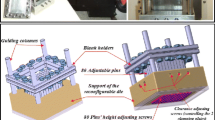Abstract
In rapid prototy** (RP) technology, prototypes are constructed by the sequential deposition of material layers. When the deposition process involves temperature gradients, thermal stresses will develop. In this paper, the prototype deformation in fused deposition modeling (FDM) processes is studied, and the essence of the deformation and the interacting principles are analyzed. According to basic hypotheses and simplifications, the mathematical model of the prototype warp deformation is constructed, and each of the influencing factors concretely, including the deposition layers number n, the stacking section length L, the chamber temperature T e, and the material linear shrinkage rate α, is quantificationally analyzed. Based on the analysis results, some issues and phenomena in the FDM process are rationally explained. Furthermore, the improving methods for the reduction of the prototype warp deformation are proposed, and the applying effect is better.
Similar content being viewed by others
References
Jayanthi S, Keefe M, Gargiulo EP (1994) Studies in stereolithography: influence of process parameters on curl distortion in photopolymer models. In: Proceedings of the Solid Freeform Fabrication Symposium, Austin, Texas, August 1994, pp 250–258
Yang H-J, Hwang P-J, Lee S-H (2002) A study on shrinkage compensation of the SLS process by using the Taguchi method. Int J Mach Tools Manuf 42(11):1203–1212
Nickel AH, Barnett DM, Prinz FB (2001) Thermal stresses and deposition patterns in layered manufacturing. Mater Sci Eng: A 317(1–2):59–64
Sonmez FO, Hahn HT (1998) Thermomechanical analysis of the laminated object manufacturing (LOM) process. Rapid Prototy** J 4(1):26–36
Detlef K, Chua CK, Du ZH (1999) Rapid prototy** issues in the 21st century. Comput Ind 39(1):3–10
Wu S (1982) Polymer interface and adhesion. Marcel Dekker, New York
Rodriguez JF, Thomas JP, Renaud JE (2000) Characterization of the mesostructure of fused-deposition acrylonitrile-butadiene-styrene materials. Rapid Prototy** J 6(3):175–185
Yardimci AM (1999) Process analysis and planning for fused deposition. PhD thesis, University of Illinois at Chicago, Illinois
Acknowledgement
This work is supported by the Shanghai Automobile Development Foundation (grant no: 0330).
Author information
Authors and Affiliations
Corresponding author
Additional information
An erratum to this article can be found at http://dx.doi.org/10.1007/s00170-006-0878-7
Rights and permissions
About this article
Cite this article
Wang, TM., **, JT. & **, Y. A model research for prototype warp deformation in the FDM process. Int J Adv Manuf Technol 33, 1087–1096 (2007). https://doi.org/10.1007/s00170-006-0556-9
Received:
Accepted:
Published:
Issue Date:
DOI: https://doi.org/10.1007/s00170-006-0556-9




